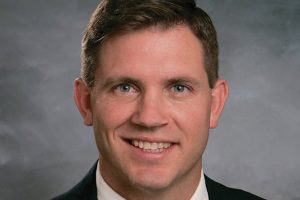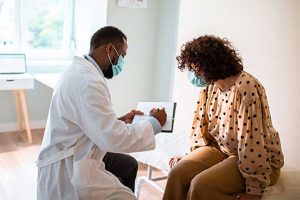By UAFP
To start, can you tell us about your life (where you grew up, went to school, etc.) and your journey to practicing family medicine?
I was born and grew up in Chile, and I wanted to be a doctor for as long as I can remember. Growing up, I was sick frequently, and I admired our pediatrician very much. When I was about six, my mom says that I went to a doctor’s visit, and I greeted him by saying, “Hola colega!” (Hi Colleague!). I always liked science and math, and I thought it was fascinating to learn how things work in our bodies. I also genuinely enjoy the opportunities to serve people that medicine provides.
Chile’s educational system is quite different from the U.S. in that high school students must decide early on what career path they want to follow. There isn’t really a pathway of general education or a bachelor’s degree; instead, university students begin their professional education after graduating from high school. Therefore, I started medical school at age 16 (because I had skipped a grade in elementary school). I attended the Universidad de Concepción School of Medicine.
Even starting medical school at such a young age, they had us visiting hospitals starting the first year. So, I had patients calling me a doctor at that young age, and I was terrified. The training was rigorous and demanding, with long hours and in a male-dominated school. I was fortunate to have great friends and classmates, where we helped and took care of each other. Residency in Chile was brutal, without regulations about the hours per week allowed. Spending a few days in a row, nonstop, was commonplace.
My husband, who is American, and I met when he was visiting Chile in December 1995. He had served a religious mission previously and was just visiting people he knew, and we miraculously (a story for another time) got together and started dating. After our marriage in January 1997, we lived in Chile for nearly four years while I finished the last years of medical school and then I practiced for almost two years at a community health center. Practicing medicine in a local community clinic after graduating was some of my most treasured times. I will cherish my time working with very humble people, with very limited resources, and feeling the love of those I constantly served.
We then moved to the U.S.; my husband did his Ph.D. at Brigham Young University in Provo, Utah, and then his Post Doc at Arizona State University in Mesa, Arizona. I worked part-time teaching anatomy and physiology at Utah Valley University and Rio Salado Community College while in Arizona. Meanwhile, I studied for and eventually passed the USMLE board exams and validated my title and academic degree. I began the process of entering the match and interviewing for a specialty. I will never forget being in the hospital the day after having had my third child. We opened up the computer to discover that I was accepted at Idaho State University in the Family Medicine Residency program. I was happy to finally be in a residency, while devastated knowing I would be gone long hours during the next three years with three small children.
The residency here in the U.S. was much better. The Idaho State University program in Pocatello, Idaho, was fantastic. Learning the U.S. system was a challenge, but my training was excellent, and I continued to polish the English language. Our residency director (Dr. Cree) was so supportive of all of us resident mothers, and even though the hours were long and hard, we were there learning, and I loved my attendings and colleagues. I felt prepared and ready to go out and practice medicine again once I finished. After completing my residency training, we moved back to Utah, where I began practicing for the University of Utah and my husband as a biology professor at Utah Valley University.
We now have four children, three girls and one boy. My widowed mother has lived with us since residency, helping me with everything from changing diapers, cleaning the house, doing the wash, and preparing meals. Between my mom, my husband and me, we make one mother.
I continue to work with the University of Utah Health, in Orem, in Family Medicine.
I love spending time with my children and hiking; we love musicals, so we love singing together, making music and practicing our religion. I enjoy running, playing the guitar, and reading alone and with my children.
How did you choose family medicine as your specialty? Also, tell me about concentrating on preventive medicine and women’s health as a family doctor?
I like family medicine because we can learn a little bit about a variety of things and see different groups of people and ages. I value the opportunity to form relationships with patients. I am grateful to be able to take care of individuals and their families throughout their lives. I especially like preventive medicine because it improves the quality of life. I like teaching people how to take care of their bodies and their families. Educating women and practicing women’s health has been a joy for me, and I know it has been helpful for many of my patients because they feel more comfortable with a female provider. I feel connected to them. It is almost like a kind of sisterhood. I want to learn more, to be able to do it right.
I must admit, I was incredibly impressed at the number of five-star reviews you received on the University of Utah website. Your patients write the most wonderful things about you. Can you tell me about the importance of building relationships with your patients? Do you think this kind of relationship-building is one of the things that make family medicine such a special and important specialty?
I believe that taking care of people is so special. They trust you with the most precious aspects of their lives, with some of their fears, doubts and even secrets. To help them, it seems crucial to get to know them, really listen and remember who they are. I have truly come to love these people over time, and I can help them more effectively when I know more about them.
As someone practicing family medicine during the COVID-19 pandemic, what has your experience been educating patients about
the virus?
It has been a learning curve. It has been a delicate balance to take care of the people with COVID without exposing other patients and staff that may be vulnerable and at higher risk of complications from the virus. We have had to be creative to give the best care. Anywhere from virtual visits, using a special room, having patients enter the building from alternative entries to reduce others’ exposures, or evaluating people with active COVID in their cars to keep others safe. I have been moved and worried about some of my patients who have been extremely sick. If they cannot breathe, I have to send them to the hospital and hope for the best.
COVID-19 has shown a light on health disparities, particularly in the early months of the virus, disproportionally affecting minority communities. As you see both English and Spanish-speaking patients, what has your experience been treating and educating patients from diverse communities during this pandemic?
I am grateful to be of service to the English and Spanish speaking community. I try to educate the best I can in regards to prevention of COVID, and on the warning signs. I have tried to be a reasonable voice to educate how to protect each other and answer questions. We are experiencing interesting and memorable times.
Even though I am not so much on the “front lines,” I feel that as family medicine physicians we have an important role in trying to take care of all the “non COVID” things, trying to preserve people’s health, and to avoid other medical problems from getting out of balance so that people can avoid having to go to the hospital, helping their mental health, not forgetting the preventive services, and using our “megaphones” for good.
UAFP
This story appears in Issue 2 2020 of the UAFP Journal.







